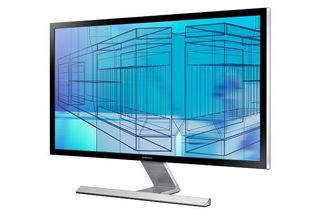Gaming in 4K: the future is now, if you give up 60 frames per second

The future—aka 4K gaming—is made up of very, very small pixels. After spending the past two weeks checking out games on Samsung's U28D590D 4K monitor, I'm still going to call 4K gaming the near future rather than the present. Yes, you can play games at 3840x2160 pixels right now. Yes, 4K monitors are becoming more affordable. But are they worth it? After spending a couple weeks using one, I can comfortably say: no, not yet. Even for a high-end graphics card (or two), 4K is too demanding for max settings and high framerates. If you're willing to play at 30 frames per second, though, 4K is a different story.
If you want to skip straight to the 4K gameplay section, click here to jump to page 2.
The Samsung U28D590D and the basics of 4K
The Samsung U28D590D is a 28-inch, 3840x2160 monitor that has an MSRP of $700, though it's only $570 on Amazon as of this writing. The monitor has a 60Hz refresh rate, unlike some earlier 4K monitors, though you'll have to use DisplayPort for 60Hz. The current HDMI spec only supports 4K at 30Hz.
I gave a general overview of the U28D590D and the demands of 4K gaming in a segment of The PC Gamer Show , which you can watch here:
The monitor looks great and I never noticed any issues with refresh rate or response time, but I didn't perform in-depth testing to determine the actual response time (never trust the too-good-to-be-true listed response time. TFT Central offers a good primer on what those specs mean). Because it uses a faster, cheaper TN panel, response time comes at a cost: inferior viewing angles and color accuracy compared to IPS displays. The monitor stand is also disappointingly limited--it has no height adjustment, rotation, or VESA mount support.
Unfortunately, if you're still running Windows 7, 4K is a terrible experience, no matter what 4K monitor you're using. The OS isn't designed to scale to such a high resolution, and everything will be impossibly tiny unless you crank up DPI scaling to 125% or 150%. But that scaling is for text—it doesn't properly resize other UI elements or affect some applications like Steam. Chrome doesn't scale its text properly, either. Windows 8 is much better about properly scaling, and requires no setup to scale text, UI elements like Windows Explorer, and applications to 4K resolution. Text in Steam and Chrome is noticeably fuzzier than system text, but everything is usable and legible without constantly squishing your face up against the monitor.
The Samsung's $570 may be cheap for a 4K monitor, but it's still expensive for a monitor, in general. What that money buys is an extremely pixel-dense display, and games really do look amazing on it. My standard monitor is a 27-inch, 2560x1440 display, which comes out to a pixel pitch rating of 108.79 PPI. That's way higher than, say, a 24-inch 1080p monitor (95.78 PPI) or a 50-inch 1080p TV (44.06 PPI).
The biggest gaming news, reviews and hardware deals
Keep up to date with the most important stories and the best deals, as picked by the PC Gamer team.

At 3840x2160, the 28-inch Samsung U28D590D has a 157.35 PPI. As a result, games running at native resolution look sharp, even without anti-aliasing enabled. The pixel density really does make a difference. Remember, a 1920x1080 monitor creates an image out of 2,073,600 pixels. A 4K monitor displays 8,294,400 pixels. As a result, a graphics card has to push out four times as many pixels. Not even two Nvidia Titans, or a newer Titan Black, can handle refreshing eight million pixels 60 times per second.
On the next page: my gaming experiences with Metro: Last Light, Tomb Raider, and other games, with some gameplay footage captured with Nvidia Shadowplay (at the max capture resolution of 1440p).

Wes has been covering games and hardware for more than 10 years, first at tech sites like The Wirecutter and Tested before joining the PC Gamer team in 2014. Wes plays a little bit of everything, but he'll always jump at the chance to cover emulation and Japanese games.
When he's not obsessively optimizing and re-optimizing a tangle of conveyor belts in Satisfactory (it's really becoming a problem), he's probably playing a 20-year-old Final Fantasy or some opaque ASCII roguelike. With a focus on writing and editing features, he seeks out personal stories and in-depth histories from the corners of PC gaming and its niche communities. 50% pizza by volume (deep dish, to be specific).
Most Popular






